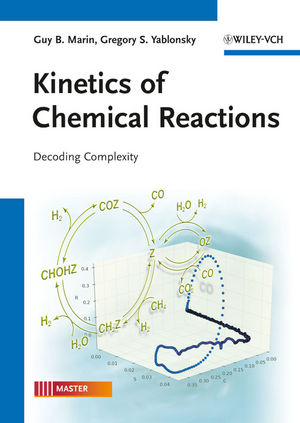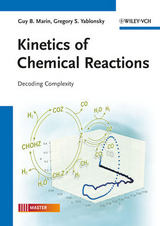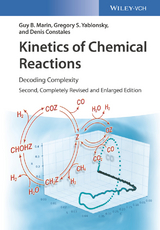Kinetics of Chemical Reactions
Wiley-VCH (Verlag)
978-3-527-31763-9 (ISBN)
- Titel erscheint in neuer Auflage
- Artikel merken
Der sehr systematisch aufgebaute Band erfasst die Kinetik in der Theorie, im Experiment und in der Anwendung. Größte Aufmerksamkeit gilt dabei natürlich der Identifizierung dominanter Reaktionswege, wichtiger Intermediale und geschwindigkeitsbestimmender Schritte, weil sich daraus Richtlinien für die Optimierung beispielsweise von Katalysen ableiten lassen. Alle Gleichungen sind so übersichtlich dargestellt, dass ihre unmittelbare Übernahme etwa für Schale up und Reaktordesign problemlos gelingt. Mit zahlreichen anschaulichen Beispielen!
Professor Guy B. Marin is chair of the Department of Chemical Engineering at Ghent University (Belgium). He received his PhD degree from Ghent University in 1980. He took a position of full professor in 1988 at Eindhoven University of Technology (The Netherlands) where he taught chemical reactors. In 1997 he returned to Ghent as director of the Laboratory for Chemical Technology. He co-authored more tan 300 papers in international journals. Professor Marin is editor-in-chief of 'Advances in Chemical Engineering' and co-editor of the Chemical Engineering Journal. Chemical reaction and reactor engineering in general and reaction kinetics in particular are the main leads in his research program. Professor Gregory S. Yablonsky obtained his academic degrees from the Boreskov Institute of Catalysis (Novosibirsk, Russia). From 1995 until 2007, he worked in the Department of Chemical Engineering at Washington University in St. Louis, USA. Since 2007, he is working at Parks College and in the Department of Chemistry at Saint Louis University. Professor Yablonsky has been a Visiting Professor at several universities, in particular the National University of Singapore and Queen's University of Belfast (N. Ireland, UK). Since 2009, Yablonsky is a Honorary Professor of Ghent University. He has served as organizer and chairman of many international conferences on chemical kinetics, catalysis, and mathematical methods in chemical engineering. He has been involved in theoretical kinetics and heterogeneous catalysis research for over 30 years, and is author of more than 200 papers and six books.
INTRODUCTION
Overview
Decoding Complexity in Chemical Kinetics
Three Types of Chemical Kinetics
Challenges and Goals. How to Kill Chemical Complexity
What our Book is Not About. Our Book among Other Books on Chemical Kinetics
The Logic in the Reasoning of This Book
How Chemical Kinetics and Mathematics are Interwoven in This Book
History of Chemical Kinetics
CHEMICAL REACTIONS AND COMPLEXITY
Introduction
Elementary Reactions and the Mass-Action Law
The Reaction Rate and Net Rate of Production of a Component - A Big Difference
Dimensions of the Kinetic Parameters and Their Order of Magnitude
Conclusions
KINETIC EXPERIMENTS: CONCEPTS AND REALIZATIONS
Introduction
Experimental Requirements
Material Balances
Classification of Reactors for Kinetic Experiments
Formal Analysis of Typical Ideal Reactors
Kinetic-Model-Free Analysis
Diagnostics of Kinetic Experiments in Heterogeneous Catalysis
CHEMICAL BOOK-KEEPING: LINEAR ALGEBRA IN CHEMICAL KINETICS
Basic Elements of Linear Algebra
Linear Algebra and Complexity of Chemical Reactions
Conclusions
STEADY-STATE CHEMICAL KINETICS: A PRIMER
Introduction to Graph Theory
Representation of Complex Mechanisms as Graphs
How to Derive the Reaction Rate for a Complex Reaction
Derivation of Steady-State Kinetic Equations for a Single-Route Mechanism - Examples
Derivation of Steady-State Kinetic Equations for Multi-Route Mechanisms: Kinetic Coupling
STEADY-STATE CHEMICAL KINETICS: MACHINERY
Analysis of Rate Equations
Apparent Kinetic Parameters: Reaction Order and Activation Energy
How to Reveal Mechanisms Based on Steady-State Kinetic Data
Conclusions
LINEAR AND NONLINEAR RELAXATION. STABILITY
Introduction
Relaxation in a Closed System
Stability - General Concept
Simplifications of Non-Steady-State Models
NONLINEAR MECHANISMS: STEADY STATE AND DYNAMICS
Critical Phenomena
Isothermal Critical Effects in Heterogeneous Catalysis: Experimental Facts
Ideal Simple Models: Steady State
Ideal Simple Models: Dynamics
Structure of the Detailed Mechanism and Critical Phenomena: Relationships
Non-Ideal Factors
Conclusions
KINETIC POLYNOMIALS
"Linear" Introduction to the Nonlinear Problem: Reminder
"Nonlinear" Introduction
Principles of the Approach: Quasi-Steady-State Approximation. Mathematical Basis
Kinetic Polynomials: Derivation and Properties
Kinetic Polynomials: Classical Approximations and Simplifications
Application of Results of the Kinetic-Polynomial Theory: Cycles Across an Equilibrium
Critical Simplification
Concluding Remarks
TEMPORAL ANALYSIS OF PRODUCTS: PRINCIPLES, APPLICATIONS AND THEORY
Introduction
The TAP Experiment
Description and Operation of a TAP Reactor System
Basic Principle of TAP
Position of TAP Among Other Kinetic Methods
Qualitative TAP Data Analysis. Examples
Quantitative TAP Data Description. Theoretical Analysis
Kinetic Monitoring: Strategy of Interrogative Kinetics
Theoretical Frontiers
Conclusions: What Next?
DECODING THE PAST
Chemical Time and Intermediates. Early History
Discovery of Catalysis and Chemical Kinetics
Guldberg and Waage's Breakthrough
Van 't Hoff's Revolution: Achievements and Contradictions
Post-Van 't Hoff Period: Reaction Is Not a Single-Act Drama
All-in-All Confusion: Attempts at Understanding
Out of Confusion: Physicochemical Understanding
Towards Mathematical Chemical Kinetics
DECODING THE FUTURE
A Great Achievement, A Great Illusion
A New Paradigm for Decoding Chemical Complexity
"Finally, this book fulfills its aim to be a systematic presentation of the addressed matter for the broad variety of chemistry lecturers and students, graduate students, physical chemists, chemical engineering students and lecturers, physics students and chemical engineers." ( Materials and Corrosion , 1 November 2012)
"It will be most useful to those chemists who have an interest in chemical engineering and/or the kinetics and mechanisms of catalysis within chemical reactors." (Chemistry World, 2012)
| Erscheint lt. Verlag | 26.7.2011 |
|---|---|
| Verlagsort | Weinheim |
| Sprache | englisch |
| Maße | 170 x 240 mm |
| Gewicht | 985 g |
| Themenwelt | Naturwissenschaften ► Chemie ► Physikalische Chemie |
| Schlagworte | catalysis • chemical engineering • chemical kinetics • Chemie • chemische Kinetik • Chemische Reaktion • Chemische Verfahrenstechnik • Chemistry • Industrial Chemistry • Katalyse • Kinetik • Maschinenbau • mechanical engineering • Physikalische Chemie • Reaktionen (chem., physikal.) • Technische Chemie • Technische u. Industrielle Chemie • thermodynamics • Thermodynamik |
| ISBN-10 | 3-527-31763-5 / 3527317635 |
| ISBN-13 | 978-3-527-31763-9 / 9783527317639 |
| Zustand | Neuware |
| Informationen gemäß Produktsicherheitsverordnung (GPSR) | |
| Haben Sie eine Frage zum Produkt? |
aus dem Bereich





